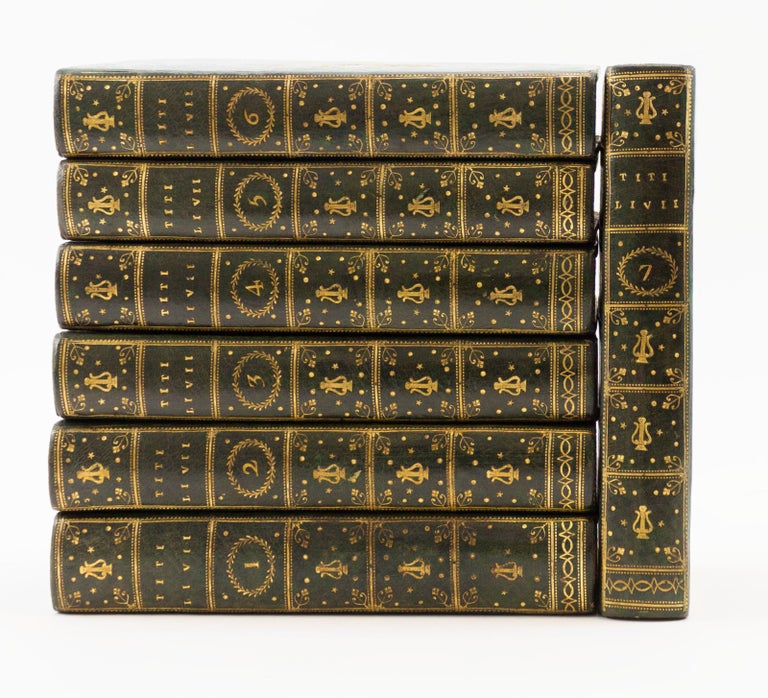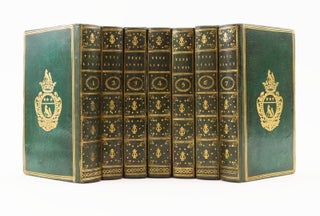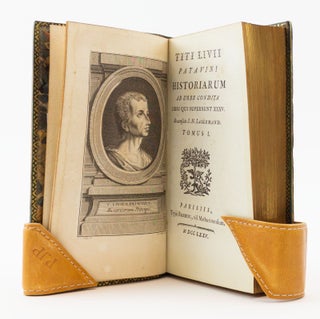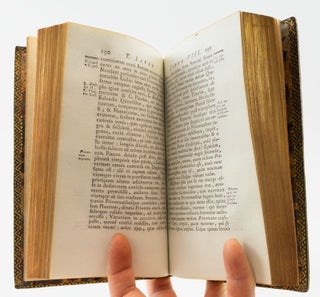TITI LIVII PATAVINI HISTORIARUM AB URBE CONDITA LIBRI QUI SUPERSUNT XXXV.
(Paris: [Joseph-Gérard] Barbou, rue Mathurins, 1775). 163 x 96 mm. (6 3/8 x 3 3/4"). Seven volumes. Edited by J. N. Lallemand; preface by Jean Baptiste Louis Crévier.
EXTREMELY ATTRACTIVE CONTEMPORARY GREEN ARMORIAL MOROCCO, perhaps by Derome, covers with triple gilt rule border, central gilt coat of arms of the Blanche family featuring a seated fox with one paw raised, above it a row of three five-pointed stars, smooth spine divided into compartments containing a gilt lyre surrounded by stars and dots, floral sprigs at corners, volume number within a laurel wreath, gilt lettering, marbled endpapers, all edges gilt. With printer's two-swans device on title pages, volume I with frontispiece portrait engraved by L. J. Cathelin after J. C. Philips. With pencilled note on front flyleaf attributing the binding to Derome. Brunet III, 1108 ("Edition estimée"); Dibdin II, 171. For the binding: Olivier, Pl. 2279. ◆Spines slightly (and uniformly) sunned, very light shelf wear to bindings, occasional faint foxing in volume IV, but A SUPERB SET, almost entirely absent of any signs of use.
This is a fine-paper copy in a binding both charming and handsome of what Dibdin deems "a truly beautiful and accurate edition" of Livy's Roman history. Brunet called it an "esteemed edition," and notes that fine paper copies like the present set sold for twice what regular copies cost. First printed by Sweynheym and Pannartz in 1469, the "Histories" of Titius Livius Patavani (59 B.C. - 17 A.D.) follow the rise of Rome from the founding of the city through its triumphs in the Punic Wars and up through the reign of the author's contemporary emperor Augustus. His account is notable for its emphasis on the glorious triumphs and accounts of heroism of the Romans, stemming in his eyes from their virtue; his history is intended not just to inform, but also to elevate the reader. The present edition, according to Dibdin, builds on the fine editions edited by Crevier and Drakenborch, incorporating their useful notes and additions. It was beautifully printed by Joseph-Gérard Barbou (1723-90?), scion of a family that had begun printing in Lyon in 1529, moving to Paris in 1540. Joseph apparently specialized in Latin classics, producing editions of Cicero, Lucretius, Pliny, Caesar, and Martial, among others. The fine binding here does not have Derome's ticket, but is well executed enough to make the attribution written in at front plausible. There were no fewer than 18 members of the Derome family (not to mention workshop associates) who made their livings as binders in Paris from the middle of the 17th century until the first quarter of the 19th. Our binding is tasteful--perfect for a scholarly edition of a classic--and conceivably the work of one of the Deromes or of an extremely competent associate. Olivier attributes our armorial stamp to the 18th century Blanche family of Burgundy, and he finds it on a copy of Barbou's 1771 Sallust in the library of Madame la Comtesse de Cossé. The "country house" condition of the present set suggests an aristocratic owner more concerned with owning fine books than with reading them. (ST17825)
Price: $5,500.00




